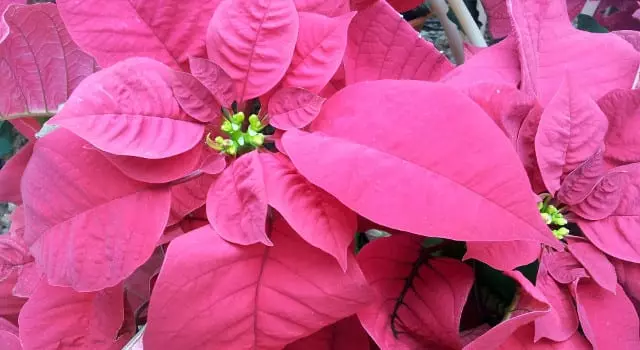Poinsettias are a favorite holiday bloom and add vibrancy and color to any home and table. Landscaping companies are often asked how these plants can be cared for year round so that they charm everyone again the next year.
Poinsettias originated from Mexico and were introduced to the U.S. in 1825. Ever since then they have become a popular Christmas gift. Poinsettias are tropical plants, with leaves or bracts are bright and attract insects to the flowers in the center of the leaves. Today poinsettias are available in a myriad of different colors but red is still most everyone’s first choice.
Landscaping company tips on choosing your plant
While in bloom, poinsettia care is easy, however people are generally tempted to discard poinsettias after the flower bracts fall. It can be a challenge to care for your poinsettia year-round and hope that it blooms again next December, but landscaping companies can share guidance and tips on how to accomplish this.
Before you get started though, it’s important to check the health of your plant to ensure that it will thrive well throughout the year. Check the leaves for wilting or drooping. The foliage should be dark green and not yellow. Check for insect infestation on the underside of the leaves. Look to see if the flowers look like fresh red or green tipped buds. This is an indicator that the plant is young and will thrive well.
It may not be possible to know if your plant was overcrowded during display, but if the pot has been encased in plastic or paper, this could cause water to collect in the wrapping.
If your plant doesn’t pass these health checks, it may be best to enjoy it as long as you can but not have any expectations of a second bloom.
A couple of basic tips can be followed to give your plant the best environment to grow in –
- Temperature and sunlight – This is a big factor when transporting the plant or even when considering plant placement. If the outside temperature is below 50℉, it’s best to cover the plant during transportation. At home, choose a sunny area as poinsettias are tropical plants and do well in the sunlight. Cold drafts or contact with cold surfaces can cause damage to the leaves.
- Humidity and watering – Check the soil and only water the plant when the soil feels dry. It’s important not to leave the plant sitting in water, so ensure that there is proper drainage. In case the air in your home is prone to be dry, you may need to mist around your plant to increase the humidity or even water more frequently.
Landscaping companies recommend a schedule for after Christmas
Following a set routine is best for poinsettias and is easy enough to accomplish yourself or with the help of a lawn care services company. Here’s how the schedule goes –
January through March – Keep an eye on the moisture levels and water your poinsettia as needed. Landscaping companies recommend maintaining a fertilization routine every 6-8 weeks using a water soluble fertilizer for houseplants.
April – From day 1, decrease the watering to allow the soil to dry out between each watering but ensure that the stem doesn’t start to shrivel. This change is to allow the plant to acclimatize to a drying process so that you can relocate it to a cool spot that has a temperature of around 60℉.
End of spring (around May) – Cut the branches back to approximately 4 inches. This is also a good time to transplant the poinsettia to a larger pot with some fresh potting soil. As with any transplant procedure, water the soil well and find a warm sunny place for your plant that has a temperature of about 65-75℉. Water when the soil feels dry to the touch. You should start seeing new growth around this time. It’s also a good time to fertilize the plant to encourage growth.
June – Your plant should now be ready for the outdoors. You can either relocate the plant in potted form to a shady area of your garden or even put the plant (pot and all) into the soil. Don’t forget to keep up your fertilizing and watering routine.
July – This is the time to “pinch” about 1 inch off the stems. Landscaping companies recommend pinching to deadhead stems with your fingers rather than using shears. This encourages the stems to branch out and also gets rid of any thin stems.
August – Within a couple of weeks, new stems should be branching out and leaves should make an appearance. This is a good time to pinch again or prune but leave about 3-4 leaves on each stem. Watering and fertilization are key at this time as the plant is growing and needs the nutrition.
September – You can now take it easy by just continuing the watering and fertilization schedule but ensure the temperature stays above 65℉. As fall approaches, it’s time to bring your poinsettia indoors and be more diligent toward its care. To encourage your plant to re-bloom, give the plant about 12 hours or less of sunlight each day. In case natural sunlight isn’t available, you may need to provide artificial light to sustain the plant.
October – From the start of the month, keep the plant in darkness for the duration of the night starting at about 5pm to 8am the following day. You may need to cover the plant to ensure no light gets through at all. During the daylight hours, relocate the plant to a sunny area of your home. Watering and fertilizing continue to be key.
November – You can now keep your plant in a sunny spot day and night. Flower buds should start to appear this month.
December – Your plant should be in bloom and you can stop fertilizing for now but keep up with your watering schedule as you did when you first brought your poinsettia home.
Poinsettias can be a challenge to care for year-round, but with a proper schedule and some tender loving care, you should be able to get your poinsettias to re-bloom. As always if you need help, give our landscape maintenance services experts a call and we’ll be happy to lend a hand.


